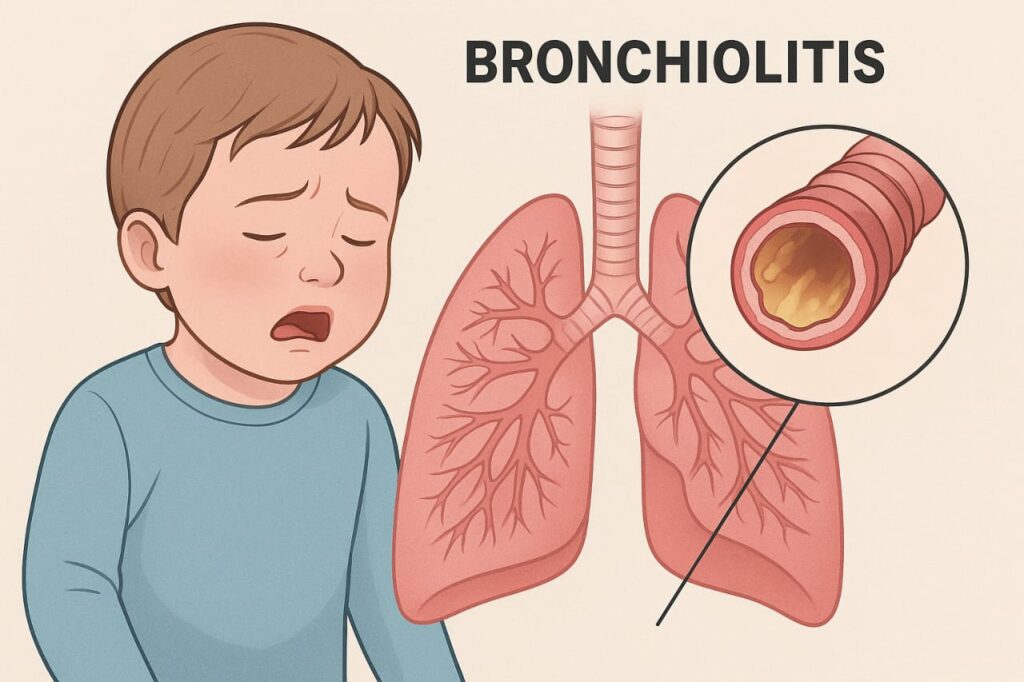Introduction Causes, Symptoms, Diagnosis, Treatment, and Prevention
Bronchiolitis is a common respiratory infection that primarily affects infants and young children, especially those under the age of two years. It occurs when the small airways in the lungs, called bronchioles, become inflamed and filled with mucus, leading to breathing difficulties.
This illness is usually caused by a viral infection, with the Respiratory Syncytial Virus (RSV) being the most common culprit.

What Is Bronchiolitis?
Bronchiolitis is a lower respiratory tract infection that affects the bronchioles, the tiniest air passages in the lungs. When infected, these airways swell, produce mucus, and restrict airflow, making it difficult for the child to breathe.
It is most common during the winter and early spring months, often spreading rapidly among children in daycare centers, schools, and hospitals.
While bronchiolitis and bronchitis sound similar, they are different conditions:
- Bronchiolitis affects the small airways (bronchioles) and occurs mainly in infants.
- Bronchitis affects larger airways (bronchi) and usually occurs in older children and adults.
Epidemiology
- Age group affected: Mostly infants under 2 years old.
- Peak incidence: Between 3 to 6 months of age.
- Season: Most cases occur between November and April.
- Global impact: Bronchiolitis is one of the leading causes of hospitalization among infants worldwide.
Causes
The main cause of bronchiolitis is a viral infection. Among several viruses, RSV (Respiratory Syncytial Virus) is responsible for about 70–80% of cases.
Common Viruses Causing Bronchiolitis
- Respiratory Syncytial Virus (RSV) – the most common cause.
- Rhinovirus – causes the common cold and can also trigger bronchiolitis.
- Parainfluenza virus – another respiratory virus linked to airway inflammation.
- Adenovirus – can cause severe respiratory illness in some infants.
- Influenza virus – especially in children during flu season.
- Human metapneumovirus (hMPV) – increasingly recognized as a cause of bronchiolitis.
How the Virus Spreads
- Through droplets when an infected person coughs or sneezes.
- By touching contaminated surfaces (toys, doorknobs) and then touching the nose or mouth.
- Close contact with infected individuals, especially in crowded places.
Risk Factors
- Premature infants (born before 37 weeks).
- Infants younger than 6 months.
- Children with congenital heart disease.
- Chronic lung disease (like bronchopulmonary dysplasia).
- Weakened immune system.
- Exposure to tobacco smoke.
- Crowded living conditions or attendance at daycare.
- Lack of breastfeeding, which reduces immunity.
Symptoms
Early Symptoms
- Runny or stuffy nose
- Mild cough
- Low-grade fever
- Sneezing
- Poor appetite
Progressive Symptoms (After 2–3 days)
- Wheezing (a high-pitched whistling sound while breathing)
- Rapid or labored breathing
- Chest retractions (skin pulling in between ribs while breathing)
- Nasal flaring
- Irritability or fatigue
- Feeding difficulty due to shortness of breath
- Bluish color (cyanosis) around lips or fingertips in severe cases
- The symptoms usually peak around day 3 to 5 and gradually improve over 7 to 14 days, though the cough may persist for several weeks.
Complications
- Dehydration (due to poor feeding).
- Apnea (temporary pauses in breathing, especially in young infants).
- Respiratory failure, requiring oxygen or ventilatory support.
- Pneumonia.
- Recurrent wheezing or asthma later in life.
Diagnosis
- Physical Examination
- Doctor checks for wheezing, rapid breathing, and chest retractions.
- Oxygen saturation may be measured using a pulse oximeter.
- Laboratory Tests (if necessary)
- Nasopharyngeal swab: To identify the virus (e.g., RSV).
- Blood tests: To check oxygen levels or detect infection.
- Imaging
- Chest X-ray: Only if the doctor suspects pneumonia or another lung problem.
- It may show hyperinflation and patchy infiltrates.
Treatment
Home Care Management
- Ensure adequate hydration:
Encourage frequent feeding and fluids to prevent dehydration. - Ease breathing:
Keep the child’s head slightly elevated.
Use a cool-mist humidifier to moisten the air.
Use saline nasal drops and suction to clear nasal mucus.
- Fever management:
paracetamol (acetaminophen) or ibuprofen as prescribed.
- Avoid exposure to smoke or strong odors.
- Monitor breathing:
Watch for signs of distress — fast breathing, bluish lips, or difficulty feeding.
Hospital Treatment
- Oxygen therapy – to maintain oxygen saturation.
- Intravenous (IV) fluids – if the child is unable to feed.
- Nasal suctioning – to clear secretions and ease breathing.
- Nebulization – sometimes used with saline or bronchodilators (though not always effective).
- Mechanical ventilation – in rare, severe cases with respiratory failure.
Prevention
- Hygiene Practices
- Wash hands frequently with soap and water.
- Disinfect toys and surfaces regularly.
- Avoid sharing utensils or bottles.
- Keep infected children at home to prevent spread.
- Avoid Exposure
- Keep infants away from crowded areas during RSV season.
- Avoid contact with people showing cold symptoms.
- No smoking near children.
- Breastfeeding
Exclusive breastfeeding for at least 6 months boosts immunity and reduces respiratory infections.
- Palivizumab (RSV Prophylaxis)
A monoclonal antibody injection given monthly during RSV season to high-risk infants, such as:
- Premature babies
- Infants with heart or lung disease
- Immunocompromised children
Frequently Asked Questions (FAQs)
- Is bronchiolitis contagious?
Yes, it spreads easily through coughs, sneezes, and contact with infected surfaces.
- Can adults get bronchiolitis?
Adults can get infected with RSV but usually show mild cold-like symptoms. Severe bronchiolitis is rare in adults.
- How long does bronchiolitis last?
Most children recover in 1 to 2 weeks, though cough and wheezing may persist for several more days.
- Is bronchiolitis the same as asthma?
No, but severe or repeated bronchiolitis can increase the risk of developing asthma later in life.
- Can bronchiolitis be prevented?
Good hygiene, avoiding smoke, and using RSV prophylaxis (Palivizumab) in high-risk infants can help prevent bronchiolitis.
